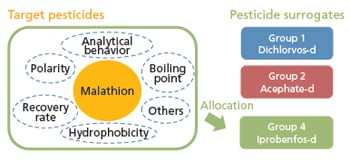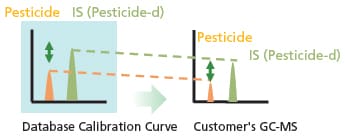GC/MS Residual Pesticides Database Ver.2 - Features
Database for GC-MS and GC-MS/MS Ver.2
Quantitation Analysis without Using Standard Samples
The database is registered with analytical conditions for 491 pesticides (retention indices, transitions, calibration curves, etc.). Retention indices can be used with the Automatic Adjustment of Retention Times (AART) function and automatic method creation function (Smart MRM™) to create quantitative analytical methods in SIM mode and MRM mode without using standard samples. The method files created are pre-registered with calibration curves created using pesticide surrogates as internal standard substances. This allows for the quantitative values to be calculated without using calibration curves obtained from standard samples.

Quantitation Analysis Using Pesticide Surrogates as Internal Standard Substances
To increase quantitative analysis precision, quantitative values must be adjusted to compensate for pesticide losses during analysis and due to variations in GC-MS(/MS) sensitivity. The pesticide surrogates used are 19 pesticides labeled with stable isotope elements that behave almost identically to the target pesticides. The calibration curves contained in this product are created by grouping target pesticides based on similar behavioral and physical properties and allocating pesticide surrogates with similar physical properties to each group as internal standard substances. This allows for quantitative values to be calculated with high precision without using calibration curves created from standard samples.
Allocation of Pesticide Surrogates Based on Physical Properties of Target Pesticides

Sensitivity Variation Adjustments Using Pesticide Surrogates
Pesticide surrogates can also be used to adjust differences in target pesticide responses observed in calibration curves and a customer's instrument due to variations in GC-MS(/MS) sensitivity.

Reliable Target Pesticide Detection of High Matrix Samples
When analyzing high matrix samples such as those that have undergone simple pretreatment by a QuEChERS method, detection and quantitation may not be achieved in either SIM mode or MRM mode due to the influence of contaminants on the target pesticides. Using two columns of different polarity allows for peak separation between the target pesticide and contaminants. This product is compatible with the Twin Line MS system, and can be used to reliably detect pesticides in high matrix samples.

Analysis can be performed smoothly on different columns without interrupting the MS vacuum by simultaneously attaching the mass spectrometer to the outlets of two different columns installed in two separate vaporizing chambers.
Accelerating All Operations, from Precision Control to Data Analysis
Rapid Precision Control with QA/QC Functions Designed Especially for Pesticide Analysis
Periodic precision control of instruments is needed to maintain the reliability of data during daily analyses. This product comes with QA/QC methods created especially for pesticide analysis. These methods allow for quick confirmation of instrument status by simply analyzing pesticide surrogates before analyzing the target sample.


Possibility of Customizing Database
This product is the world's only customizable database for residual pesticide screening. Additional analytical conditions (including calibration curve information) can be added to the database. Also, the target pesticides being measured can be changed for each sample, allowing the customer to analyze particular target pesticides.



